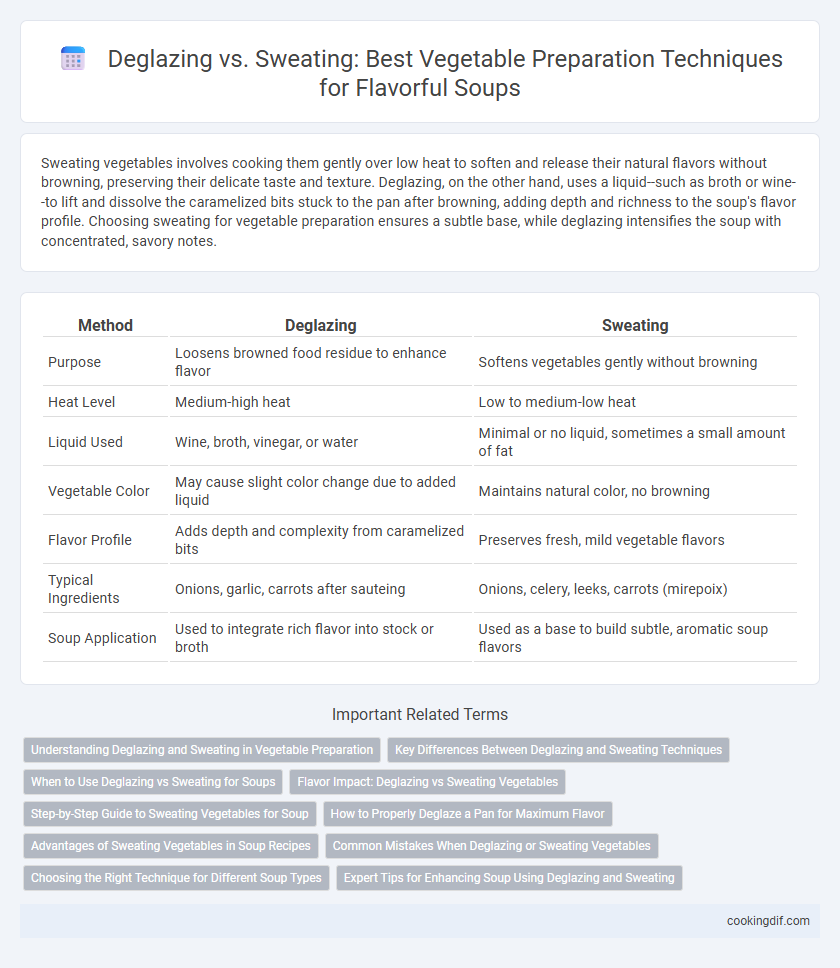Sweating vegetables involves cooking them gently over low heat to soften and release their natural flavors without browning, preserving their delicate taste and texture. Deglazing, on the other hand, uses a liquid--such as broth or wine--to lift and dissolve the caramelized bits stuck to the pan after browning, adding depth and richness to the soup's flavor profile. Choosing sweating for vegetable preparation ensures a subtle base, while deglazing intensifies the soup with concentrated, savory notes.
Table of Comparison
| Method | Deglazing | Sweating |
|---|---|---|
| Purpose | Loosens browned food residue to enhance flavor | Softens vegetables gently without browning |
| Heat Level | Medium-high heat | Low to medium-low heat |
| Liquid Used | Wine, broth, vinegar, or water | Minimal or no liquid, sometimes a small amount of fat |
| Vegetable Color | May cause slight color change due to added liquid | Maintains natural color, no browning |
| Flavor Profile | Adds depth and complexity from caramelized bits | Preserves fresh, mild vegetable flavors |
| Typical Ingredients | Onions, garlic, carrots after sauteing | Onions, celery, leeks, carrots (mirepoix) |
| Soup Application | Used to integrate rich flavor into stock or broth | Used as a base to build subtle, aromatic soup flavors |
Understanding Deglazing and Sweating in Vegetable Preparation
Sweating vegetables involves gently cooking them in fat over low heat to soften and release moisture without browning, preserving their delicate flavors and textures essential for soups. Deglazing follows by adding liquid, such as stock or wine, to the pan after sauteing or browning vegetables, lifting caramelized bits to enhance depth and richness in the soup's flavor profile. Mastering sweating and deglazing techniques maximizes vegetable taste development and creates a robust, flavorful soup foundation.
Key Differences Between Deglazing and Sweating Techniques
Sweating vegetables involves cooking them gently over low heat to soften and release moisture without browning, preserving their natural flavors and textures. Deglazing uses liquid, such as broth or wine, added to a hot pan after sauteing to dissolve browned bits stuck to the surface, enhancing the depth and richness of soups. While sweating is primarily a method to develop sweetness and tenderness in vegetables, deglazing is a technique to extract and incorporate concentrated flavors into the cooking liquid.
When to Use Deglazing vs Sweating for Soups
Sweating vegetables is ideal at the start of soup preparation to gently soften ingredients like onions, celery, and carrots without browning, preserving a delicate flavor base. Deglazing is best used after sauteing meat or caramelizing vegetables to lift flavorful browned bits from the pan, enriching the soup's depth and complexity. Choosing sweating for aromatic vegetables and deglazing for flavor enhancement creates a balanced and layered soup profile.
Flavor Impact: Deglazing vs Sweating Vegetables
Sweating vegetables involves cooking them gently in oil or butter at low heat to soften and release natural sugars, enhancing their sweetness and depth in soups. Deglazing captures the browned bits left in the pan after sauteing or roasting, adding rich, caramelized flavors and complexity to the soup base. Combining sweating and deglazing techniques maximizes flavor layers, balancing subtle sweetness with savory, umami notes.
Step-by-Step Guide to Sweating Vegetables for Soup
Sweating vegetables for soup involves gently cooking chopped onions, carrots, and celery in a small amount of oil or butter over low heat to soften and release their natural sweetness without browning. Stir frequently and cover the pan to trap moisture, allowing the vegetables to cook evenly and develop flavor. This technique enhances the base of the soup by creating a mellow, aromatic foundation crucial for rich and balanced broth.
How to Properly Deglaze a Pan for Maximum Flavor
To properly deglaze a pan for maximum flavor in soup preparation, first remove cooked vegetables and ensure the pan is hot with browned bits (fond) sticking to the bottom. Pour a small amount of liquid such as broth, wine, or water into the pan and scrape the fond with a wooden spoon to dissolve the concentrated flavors into the liquid. This technique intensifies the soup's taste by incorporating caramelized vegetable residues, unlike sweating, which gently cooks vegetables to release moisture without browning.
Advantages of Sweating Vegetables in Soup Recipes
Sweating vegetables in soup recipes enhances flavor development by gently softening ingredients without browning, preserving their natural sweetness and moisture. This technique releases aromatic compounds steadily, creating a rich, balanced base that intensifies the overall taste of the soup. Sweating also maintains a clean, clear broth appearance, ideal for delicate and light soup preparations.
Common Mistakes When Deglazing or Sweating Vegetables
Common mistakes when deglazing vegetables include using too much liquid at once, which can prevent proper caramelization and flavor development. Sweating vegetables often goes wrong when the heat is too high, causing browning instead of softening and releasing moisture. Overcrowding the pan during either process traps steam, leading to soggy textures rather than flavorful, tender vegetables ideal for soups.
Choosing the Right Technique for Different Soup Types
Deglazing enhances soups like French onion or beef broth by lifting caramelized flavor compounds from the pan, adding depth and richness. Sweating vegetables suits lighter soups such as minestrone or vegetable broth, gently softening ingredients without browning to preserve fresh, delicate flavors. Selecting the right technique depends on the soup's desired taste profile and cooking method, balancing flavor intensity and ingredient texture.
Expert Tips for Enhancing Soup Using Deglazing and Sweating
Sweating vegetables gently in a pan releases their natural sweetness and softens them without browning, creating a rich, flavorful base for soups. Deglazing with wine, broth, or vinegar lifts caramelized bits from the pan, infusing the soup with deep, complex umami layers. Expert chefs recommend sweating first to build subtle depth, then deglazing to capture intense, savory notes that elevate the overall soup flavor profile.
Deglazing vs Sweating for vegetable preparation Infographic

 cookingdif.com
cookingdif.com